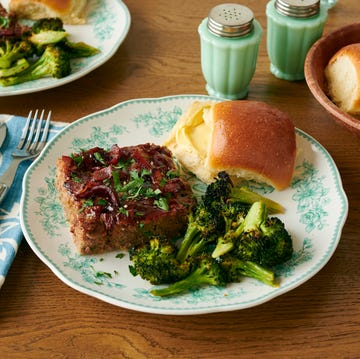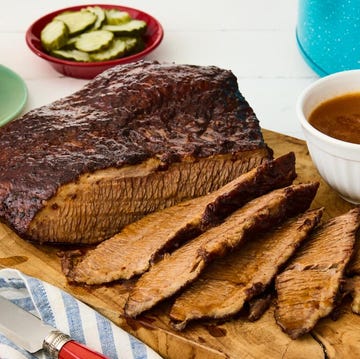
Yields:
4 serving(s)
Prep Time:
35 mins
Total Time:
3 hrs 5 mins
You don't have to spend a fortune every time you're craving a good steak. Hanger steak is a more affordable option compared to your ribeyes and filets, but let me tell you—when it's prepared the right way, I'd stack it up against just about any cuts of beef out there. It's that good.
The secret to hanger steak's success comes down to three simple things: how you season it, how you cook it, and how you slice it. This cut of beef absolutely loves a good marinade—it soaks up all those flavors beautifully. And the longer you let it marinate, the better it gets (just don't let it go past 12 hours or it can start to break down).
Hanger steak is at its best when cooked to medium-rare. Trust me on this: It can get tough and chewy if you overcook it, and nobody wants that. But at medium-rare, it's tender, juicy, and slices like a dream. (You can learn more about temperatures by referring to this handy-dandy steak doneness chart.) And speaking of slicing, here's the golden rule: always cut hanger steak against the grain. It makes all the difference in the world. More on that below!
If you love steak dinner recipes as much as me, this is a great one to add to your list of summer dinners, since it's cooked on the grill.
What is hanger steak?
Hanger steak is a long, flat cut of beef from the plate section, located in the cow's upper belly. Sometimes it's called butcher's steak, since it's said that butchers would keep this delicious cut for all for themselves. Hanger steak has a great beefy flavor and is similar to flank and skirt steak, but with a little more marbling so it's more tender.
How do you remove the membrane?
For a tender hanger steak, you need to remove the membrane before marinating and cooking. You can have your butcher do it or do it yourself! First, lay the steak flat on a cutting board. Look for the tough, white membrane that's running down the center, dividing it into two halves. This is what you need to remove. Use a sharp knife to carefully cut along one side of the membrane, separating one half of the steak from it. Repeat on the other side to fully remove the membrane. (Grip the membrane with a paper towel if it is slippery.) Take a look at the steaks and trim away any leftover bits of silvery skin. Now they're ready for marinating!
What does it mean to cut a steak against the grain?
Cutting a steak against the grain means slicing the meat perpendicular to the direction of its muscle fibers. These fibers are the long, visible lines that run through the meat, and they can make a steak tough and chewy if not cut properly. By cutting against the grain, you break these fibers into shorter, thinner sections, which makes the meat significantly easier to chew and more tender. Cutting against the grain is especially important for tougher steaks like hanger, flank, and skirt.
Advertisement - Continue Reading Below
Ingredients
- 1/4 cup
olive oil
- 1/4 cup
Worcestershire sauce
- 2 Tbsp.
red wine vinegar
- 1 Tbsp.
dijon mustard
- 1 Tbsp.
rosemary, finely chopped
- 2
garlic cloves, finely chopped
- 1
hanger steak (1 ½ to 2-pounds), membrane removed and steak cut in half lengthwise
- 1/4 tsp.
kosher salt
- 1/2 tsp.
black pepper
Vegetable oil, for the grill
Flaky salt, for sprinkling
Directions
- Step 1In a shallow baking dish, whisk together the olive oil, Worcestershire sauce, vinegar, mustard, rosemary, and garlic.
- Step 2Add the hanger steaks to the marinade, turn to coat, cover, and refrigerate at least 2 hours and up to 12 hours, flipping the steaks once for an even marinade.
- Step 3Thirty minutes before you are ready to cook, remove the steak from the refrigerator. Remove the steak from the marinade and pat dry. Sprinkle all over with the salt and pepper.
- Step 4Heat a grill to medium-high heat (about 400˚F to 450˚F) for 5 to 10 minutes until hot. Scrub the grill grate with a grill brush. With a pair of tongs, dip a paper towel or clean rag in some vegetable oil (do not soak it) and wipe it over the grates. Place the steaks directly over the flame and cook, covered, until a thermometer inserted in the thickest part reaches 135˚F, 5 to 7 minutes per side for medium-rare. Transfer to a cutting board, tent with foil, and let rest for 5 minutes before slicing against the grain and sprinkling with flaky salt.
Advertisement - Continue Reading Below

Make Meatball Casserole For Dinner This Week

Sheet Pan Glazed Meatloaf Is A Cozy Dinner

Cowboy Spaghetti Is A Hearty Weeknight Dinner

Ree's Swiss Steak Is The Perfect Weeknight Meal
Advertisement - Continue Reading Below
Advertisement - Continue Reading Below







